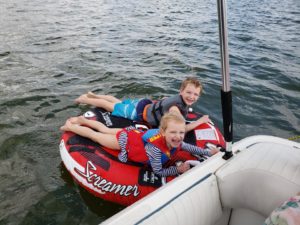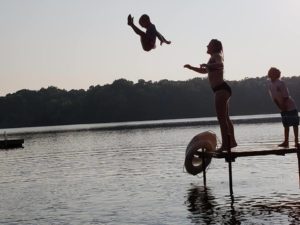With the summer months right around the corner, the chance for days in the pool or at the beach increase. I love spending time at the lake swimming with my kids, but there is also the danger with kids in the water. There are a few rules and strategies that we have tried to use to keep our kids safe around the water, but no matter how careful you are, there is always some risk with being near water.
First, we got our kids in the water from infancy onward. When they were infants we took them to the pool as often as we could so that they would get used to the water. When I was a swim instructor, one of the hardest things was to convince kids who were scared to death of the water to come and get in the pool. Being comfortable in the water takes some time for kids, but the earlier you start, the easier it tends to be.
Even as babies and toddlers we would get them used to getting their face wet. If you blow a little puff of air in their face, they will close their eyes and mouth, so they don’t mind getting their face wet. They also take a lot of cues from parents, so we would get their faces wet and then cheer and smile and say how fun it was. Eventually, it just becomes a normal part of swimming or bath time.
Second, we got our kids involved in swimming lessons. My husband and I met at a pool as lifeguards and swim instructors, so we know how to teach kids how to swim, but we still enrolled our kids in swimming lessons once they turned 2-3 years old. There is just something about being in a class with a non-parent adult that gets our kids to listen and focus on swimming. This is fine by me, as we can focus on having fun in the water, and they still get scheduled time to work on their skills.
Third, the kids spent some time in the water with and without flotation devises. I’ve seen a number of kids who always have floaties on. The one issue is that they sometimes get overconfident in their swimming ability, which can get them into trouble. There are some times that we require life jackets (like at the beach), but we always make sure that they get some time without floaties so that they know how much work it is to keep themselves up on their own.
Fourth, we try to enforce basic water safety. For example, we make sure our kids know that they can never get in the water (even just their feet) unless an adult is there and tells they it is ok. Of course, there is a lot of reminding, but we are as consistent with this as we can be.
We also try to coordinate with whatever adults we are with to make sure there is always an adult assigned to watch each kid. This way we avoid the problem of an adult walking away from the water, thinking that others are still watching the kids.
Finally, we don’t trust kids near the water. Some of the highest rates of drowning are in kids who have recently learned to swim. Both parents and kids can be overconfident in the child’s ability, and this can very quickly lead to trouble.

I love the water and want my kids to love it, too, but it can be dangerous, even with all of the proper precautions. But with all of the beautiful lakes and pools around Wisconsin, I’m ready to get out in the water this summer!

















